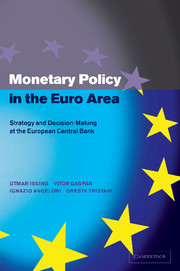Book contents
- Frontmatter
- Contents
- List of figures
- List of tables
- Acknowledgements
- Introduction
- 1 Money, output and prices: the scope of monetary policy
- 2 Monetary policy making: strategies and rules
- 3 The euro area: an overview
- 4 The ECB strategy: defining price stability
- 5 The role of money
- 6 A broadly based assessment
- 7 The ECB strategy: an overall view
- 8 The operational framework
- 9 Accountability and transparency
- 10 The single monetary policy in 1999
- Appendix Excerpts from ECB external communications to the press
- References
- Index
3 - The euro area: an overview
Published online by Cambridge University Press: 22 September 2009
- Frontmatter
- Contents
- List of figures
- List of tables
- Acknowledgements
- Introduction
- 1 Money, output and prices: the scope of monetary policy
- 2 Monetary policy making: strategies and rules
- 3 The euro area: an overview
- 4 The ECB strategy: defining price stability
- 5 The role of money
- 6 A broadly based assessment
- 7 The ECB strategy: an overall view
- 8 The operational framework
- 9 Accountability and transparency
- 10 The single monetary policy in 1999
- Appendix Excerpts from ECB external communications to the press
- References
- Index
Summary
After the general discussion of the functioning of monetary economies and of different theoretical approaches to monetary policy making, this chapter starts to focus on the economic area that adopted the single currency at the beginning of 1999. The euro area is characterised from three different viewpoints. Section 3.1 describes its broad economic features, as compared to those characterising both its constituent countries and other large world economies. The important challenges faced in the field of data construction are analysed next, in section 3.2, with special emphasis on two entirely new statistical products: the Harmonised Index of Consumer Prices (HICP) and the new monetary aggregates. Section 3.3 concludes, providing some tentative quantitative evidence on the basic features of the monetary policy transmission mechanism.
Salient features of the euro area economy
The economic area emerging from the launch of Stage Three of the process of European monetary unification, namely the euro area, is, for evident reasons, very similar to the economies of all participating countries.
Some common traits are rather obvious. All national economies are characterised by broadly similar sectoral patterns of production (see table 3.1). The services sector is by far the largest in all countries, accounting for an average of 69 per cent of total GDP in the area, with Luxembourg and Ireland being the countries in which it is largest and smallest, respectively.
- Type
- Chapter
- Information
- Monetary Policy in the Euro AreaStrategy and Decision-Making at the European Central Bank, pp. 47 - 64Publisher: Cambridge University PressPrint publication year: 2001



